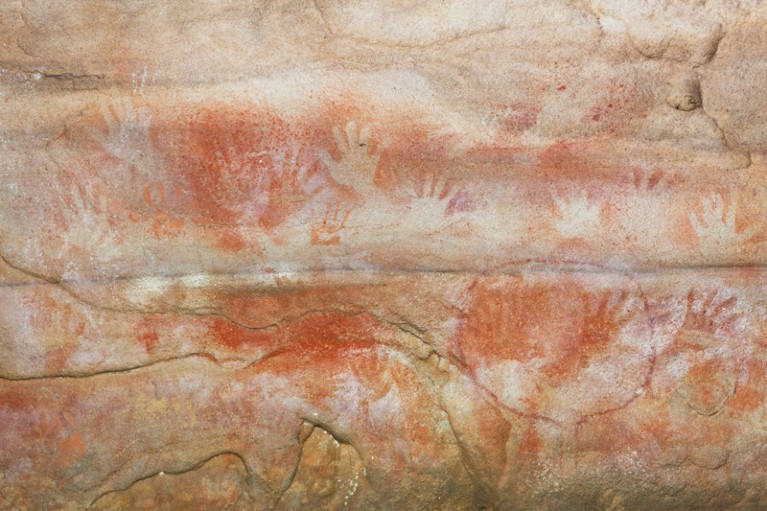Hello Nature readers, would you like to get this Briefing in your inbox free every day? Sign up here

Researchers worry soot may have damaged rock art in the Blue Mountains, similar to these stencils in Red Hands Cave.Credit: Marc Anderson/Alamy
Fears for Aboriginal sites damaged in fires
Thousands of ancient Aboriginal sites and artefacts have probably been damaged or destroyed by the catastrophic fires in Australia. Tens of thousands of sites — including rock art, stone-tool sites and trees that have been altered for traditional uses — are at risk from fires and from the water dropped to fight the flames. One small ray of hope: in at least one case, fires opened up areas of dense vegetation and revealed previously undocumented finds.
Wuhan in lockdown over virus outbreak
Authorities have suspended all travel in and out of Wuhan, the Chinese city at the centre of an outbreak of a new respiratory virus. Flights and trains leaving the city of 11 million people have been suspended, along with public transport within the city. The move might slow the international spread of the virus, but might also have “created a large cell-culture dish in which all these people will share the infection and create a lot more cases all stuck in Wuhan”, says virologist Ian Mackay.
Nature | 5 min read (this story will be continuously updated with news about the Wuhan respiratory illness)
Reproducibility score for life-science papers
Life-science researchers are getting better at communicating science in a rigorous and reproducible way, according to a text-mining analysis of around 1.6 million papers. Software gave ‘rigour and transparency’ points for things such as naming the specific reagents used and including sample-size calculations. Between 1997 and 2019, the average score across all the papers tested more than doubled, from 2 out of 10 to 4.2. Among journals, the average score has increased since 1997, but no title scored more than 5.
Reference: bioRxiv preprint
The gender pay gap in unprecedented detail
A study of every academic in New Zealand finds that a woman with the same productivity and research impacts as her male colleague can expect to earn an average of NZ$200,000 (US$132,000) less over a lifetime. New Zealand universities follow a standard scale for pay and academic advancement, and is the only country in the world that scores every academic’s research impact. This allowed researchers to quantify the gender pay gap in fine detail for the first time.
Features & opinion
Outbreaks are the new normal — we need trust to fight them
Wuhan is a strong virology hub that is well-equipped to deal with the outbreak of a deadly respiratory virus, notes a Nature Microbiology editorial. Scientists in China have demonstrated prompt, transparent and thorough outbreak reporting and joined in on Twitter for unprecedented communication and discussion in real time. Their efforts should be met with proper credit, argues the editorial — not least because breaking their trust could hinder the response to future outbreaks.
Nature Microbiology | 4 min read
The lesser-known radioactive waste
Every year, oil and gas wells in the United States produce nearly 4 trillion litres of ‘brine’: water contaminated with radioactive isotopes pulled up from beneath Earth’s surface. Because it is naturally occurring and exempted from some environmental regulations, brine has avoided the oversight and scientific scrutiny of nuclear waste. Rolling Stone investigates how this lesser-known toxic waste is affecting workers and communities.
Step inside Armenia’s Soviet-era cosmic-ray lab
In its Soviet heyday, the Aragats Cosmic Ray Research Station in Armenia hosted up to 100 scientists who probed the high-energy particles that come from space. Now the mountaintop station has lost much of its funding and staff and is peppered with abandoned equipment. But with a refocus on solar and atmospheric physics, the lab has increased its publications tenfold in the past two decades.
